Want to stay ahead of social media trends? AI tools can help you analyze, monitor, and predict activity across platforms like Instagram, Twitter, and Facebook. But should you go for free tools or invest in paid ones? Here’s the breakdown:
- Free tools: Great for beginners or small businesses. They offer basic features like engagement tracking and audience demographics but are limited to single platforms and short data histories.
- Paid tools: Ideal for agencies and larger teams. They provide advanced features like sentiment analysis, cross-platform reports, and predictive insights, but come at a cost, starting around $15/month to over $200/month for premium options.
Quick Comparison
| Feature | Free Tools | Paid Tools |
|---|---|---|
| Best For | Individuals, small businesses | Marketing teams, agencies |
| Trend Detection | Basic, broad trends | Advanced, niche-specific |
| Platform Support | Single platform | Multiple platforms |
| Data History | Limited (e.g., 30 days) | Extensive (up to 2 years) |
| Price | Free | $15–$249/month (typical range) |
Free tools are perfect for basic needs, while paid tools offer deeper insights for scaling your efforts. Start small, then upgrade as your needs grow.
Free AI Tools for Social Media Trend Analysis
What Free AI Tools Offer
Free AI tools provide basic analytics like tracking engagement, reach, follower growth, and audience demographics. These tools are often built into specific social media platforms and focus on analyzing data from only one channel at a time.
Platform-specific tools dominate the market. For example, Facebook Insights tracks metrics like page likes, post reach, and audience demographics. Instagram Insights offers data on profile visits, website clicks, and follower activity. Twitter Trending highlights real-time popular hashtags and keywords, while Pinterest Trends provides growth tracking with basic interest and demographic filters.
Some third-party tools also offer free plans, though with limited features. For instance, Pallyy provides up to 30 days of analytics for Instagram and LinkedIn, along with custom reports, but restricts access to historical data. These tools typically include simple reports with basic charts, focusing on key performance indicators without advanced customization.
Filtering options in free tools are usually basic, covering broad categories rather than highly specific insights. While limited, these features can still deliver valuable insights for users who need cost-effective solutions.
Benefits of Free Tools
The biggest perk of free tools is their cost - or lack thereof - making them accessible to individuals, startups, and small businesses operating on tight budgets. They integrate directly into social media platforms, requiring little to no setup or technical expertise.
These tools are ideal for beginners, helping users understand core metrics before moving on to more advanced analytics. With immediate data access, users can quickly monitor high-level trends, identify top-performing posts, track trending hashtags, and observe follower growth in real time. While useful, these tools do come with some limitations.
Limits of Free Tools
Free tools, while helpful for basic insights, lack the depth of paid options. Advanced features like sentiment analysis, competitor benchmarking, and automated reporting are typically unavailable.
Another drawback is the restricted data history. For example, Pallyy’s free plan limits users to 30 days of data, making it hard to track seasonal trends or analyze campaigns lasting several months. This short timeframe hinders a deeper understanding of long-term audience behavior.
Platform-specific restrictions are another challenge, as these tools focus on analyzing one channel at a time. For those managing multiple accounts across different platforms, switching between tools can be time-consuming.
The absence of integration with other marketing tools also limits reporting and workflow automation. Without export options, combining social media metrics with data from sources like website traffic or email campaigns becomes cumbersome.
Lastly, free tools often focus on broad, mainstream trends rather than niche insights. This makes it harder to uncover emerging opportunities within specialized industries or communities.
| Tool Name | Key Features | Supported Platforms | Main Limitations |
|---|---|---|---|
| Facebook Insights | Engagement, reach, audience demographics | Facebook only | Basic metrics; no cross-platform analysis |
| Instagram Insights | Profile visits, website clicks, follower activity | Instagram only | Limited to Instagram data; basic reporting |
| Twitter Trending | Real-time trending hashtags and keywords | Twitter/X only | Generic trends; lacks niche focus |
| Pinterest Trends | Trend growth status, demographic filtering | Pinterest only | Broad topics only; limited customization |
| Pallyy (Free Plan) | 30-day analytics, custom reports | Instagram, LinkedIn | Restricted data history; basic features |
Paid AI Tools for Social Media Trend Analysis
What Paid AI Tools Offer
Paid AI tools go beyond the basics, delivering advanced insights across multiple platforms. These tools use machine learning to provide features like predictive trend modeling, in-depth competitor analysis, and AI-driven insights. Unlike free tools, they offer real-time benchmarking, detailed sentiment analysis, and comprehensive cross-platform reports.
These platforms cover a wide range of channels, including Facebook, Instagram, LinkedIn, TikTok, YouTube, Pinterest, and X. They also extend their reach to other digital spaces like blogs, forums, videos, podcasts, and reviews. Enterprise-level solutions take it further by offering market intelligence and audience segmentation, breaking down data by content type and competitor activity - capabilities that free tools simply can't match.
For businesses and agencies looking for detailed, scalable solutions, these features provide a significant edge.
Benefits of Paid Tools
One of the standout advantages of paid tools is their advanced analytics dashboards and customizable reporting. While free tools often limit historical data access, paid options allow for up to two years of data, making it easier to analyze long-term trends and seasonal patterns.
Another major plus is scalability. Many paid platforms accommodate unlimited users, making them ideal for agencies managing multiple brands or large teams. They also streamline operations with features like workflow automation and team collaboration tools.
Agencies have reported stronger campaigns thanks to real-time benchmarking and automated reporting. Brands also benefit from the ability to quickly address negative sentiment, which helps protect their reputation and refine content strategies.
Integration is another key feature. Paid tools often connect seamlessly with existing marketing systems, enabling unified workflows, ROI tracking, and automated processes. Their predictive analytics capabilities allow businesses to spot emerging trends early, enabling proactive decision-making instead of reactive adjustments.
However, these benefits come with certain challenges.
Downsides of Paid Tools
The most obvious drawback is the cost. Prices range widely, from basic plans to expensive enterprise options, which can be a hurdle for small businesses or individual creators. Additionally, the advanced features of these tools often require significant training and onboarding time.
Customization and sophisticated analytics, while powerful, can overwhelm users who are new to these platforms. Many organizations may find themselves paying for features they don’t fully utilize. Moreover, these tools require ongoing optimization to ensure they deliver maximum value.
| Tool Name | Monthly Price | Advanced Features | Platform Coverage | Main Limitations |
|---|---|---|---|---|
| Brand24 | $24 | Automated sentiment analysis, real-time monitoring | Social, news, blogs, forums, videos, podcasts, reviews | Learning curve for advanced features |
| Pallyy | $25 | Two years historical data, competitor benchmarking | Instagram, LinkedIn | Limited platform support |
| Sociality.io | $99 | Unlimited users, enterprise analytics | Facebook, Instagram, X, LinkedIn, YouTube | Higher cost for small teams |
| Socialinsider | $99 | AI-driven content pillar insights, competitor analysis | Facebook, Instagram, LinkedIn, TikTok, YouTube, X | Complex feature set requires training |
| Hootsuite | ~$110 | Enterprise dashboards, cross-platform benchmarking | Facebook, Instagram, LinkedIn, TikTok, Pinterest, YouTube, X | Overwhelming for beginners |
| Sprout Social | $199 | AI analytics, team collaboration, real-time competitor benchmarking | Facebook, Instagram, LinkedIn, TikTok, YouTube, X | High cost, complex setup |
| Quid (NetBase) | ~$23,000/year | Market intelligence, advanced sentiment analysis | Social, blogs, forums, customer data | Extremely high cost, enterprise-only |
Free vs Paid AI Tools: Feature Comparison
Feature and Benefit Comparison
Here’s a look at how free and paid AI tools stack up against each other:
| Feature | Free Tools | Paid Tools |
|---|---|---|
| Best For | Solo creators, small businesses | Agencies, large companies, enterprises |
| Trend Detection | Basic, broad trends | Advanced, niche-specific, predictive |
| AI Insights | Limited or none | Deep, actionable, custom models |
| Reporting | Basic, limited history (30 days) | Custom, automated, extensive history (up to 2 years) |
| Social Listening | Rare or basic | Real-time sentiment analysis |
| Competitor Analysis | Minimal or absent | Comprehensive, multi-platform |
| Platform Support | Single platform | Multiple platforms, unified dashboard |
| Customer Support | Limited/community | Dedicated, fast response, onboarding |
| Price (USD) | Free | $15–$249/month (typical range) |
A major distinction lies in platform coverage. Free tools are often limited to a single platform - for example, Twitter Trending focuses solely on Twitter, while Pinterest Trends is exclusive to Pinterest data. Paid tools, on the other hand, support multiple platforms (often five or more) and offer unified dashboards that simplify managing content and analytics across channels.
These differences are key in determining which type of tool aligns with a user’s goals.
Which Users Should Choose Each Option
The choice between free and paid tools largely depends on your specific needs and budget.
For solo creators or small businesses operating on limited funds, free tools are a practical starting point. They’re ideal for basic tasks, like managing a single Instagram account or identifying broad industry trends on Twitter. While these tools don’t offer in-depth analytics or competitor data, they provide enough functionality to get the job done without any financial commitment.
Agencies and marketing teams, however, often require the advanced capabilities of paid tools. Managing multiple client accounts demands features like team collaboration, detailed reporting, and comprehensive analytics. Paid solutions are built to handle these complexities, making them indispensable for professionals working at scale.
For large companies and enterprises, paid tools are a must from the outset. Features like real-time sentiment analysis, predictive analytics, and competitor benchmarking are crucial for strategic, data-driven decision-making. Additionally, these organizations often benefit from dedicated customer support and onboarding services, ensuring seamless integration into their workflows.
If you’re looking for a balance between affordability and functionality, tools like Vista Social offer a compelling option. Starting at $15/month, it provides robust management features without the hefty price tag of high-end platforms.
Free tools are great for starting small, but as your analytics needs grow and your audience expands, investing in a paid solution unlocks the deeper insights and advanced features necessary for long-term success.
sbb-itb-212c9ea
How to Choose the Right AI Tool for Social Media Trend Analysis
What to Consider When Choosing
When selecting an AI tool for social media trend analysis, it’s important to weigh several factors, such as budget, team size, features, scalability, integration, and data privacy. These considerations will help you find a tool that aligns with your specific needs.
Budget and team size play a key role in narrowing down your options. Free tools are ideal for individuals or small businesses, offering basic trend discovery without any cost. On the other hand, larger teams or agencies often require tools with multi-user support, advanced permissions, and collaborative reporting features. Paid platforms typically start at $15-$99 per month and provide these capabilities.
Features should directly support your business goals. For straightforward tasks like tracking engagement or monitoring follower growth, the analytics tools built into social media platforms might suffice. However, if your needs are more advanced - such as real-time sentiment analysis, competitor benchmarking, or spotting future trends - AI-powered tools with broader functionalities will be more suitable. Matching the tool’s features to your objectives ensures better outcomes.
Scalability is another critical factor, especially if your business is expanding. Look for tools that offer tiered pricing and modular features, allowing you to scale up as needed. For example, Pallyy provides a free plan with 30 days of historical data, while its premium plans, starting at $25 per month, offer up to two years of data.
Integration capabilities are essential for seamless workflows. Ensure the tool supports major U.S. platforms like Facebook, Instagram, X (Twitter), LinkedIn, TikTok, and YouTube. Additionally, check if it can connect with your CRM, email marketing software, or other business tools.
Lastly, data privacy compliance is particularly important for U.S. businesses. Choose tools that adhere to U.S. data privacy regulations and use formats like MM/DD/YYYY and USD currency.
How AI Apps Can Help

Once you’ve outlined your needs, using a centralized platform can make the search for the right tool much simpler.
AI Apps is a platform designed to streamline this process for U.S. businesses. It offers access to over 1,000 AI tools across various categories, allowing you to filter options based on pricing, features, or industry focus. For example, you can narrow your search to tools specifically designed for Social Media Managers, Marketers, or Content Creators.
With pricing filters, you can quickly identify free, freemium, or paid tools that fit your budget, skipping over options that don’t meet your financial requirements. The platform also lets you compare tools side-by-side, evaluating features, pricing, and target audiences to make an informed decision.
AI Apps goes a step further by highlighting newly launched and featured tools, keeping you up-to-date on the latest advancements in social media analytics. For businesses that prefer a structured approach, the platform supports every step of the selection process - from setting goals and assessing budgets to shortlisting tools that meet your criteria. Its verification process ensures that the listed tools are reliable and effective, saving you from investing in solutions that might fall short of expectations.
Top 10 AI Tools for Social Media in 2025
Conclusion
Deciding between free and paid AI tools ultimately comes down to your business needs and budget. Free options like Twitter Trending and Pinterest Trends are great for basic tracking but are limited in scope and platform coverage. On the other hand, paid tools offer more robust features. For instance, Brand24 starts at $24 per month, while high-end platforms like Quid can cost around $23,000 annually. These paid solutions often include advanced features such as sentiment analysis, cross-platform integration, and access to more extensive historical data.
While free tools provide simplicity, paid tools deliver deeper insights and broader functionality. For example, small e-commerce brands might benefit from free tools like Instagram Insights to improve engagement. In contrast, digital agencies often find value in paid tools like Sprout Social, which can save up to 30% of the time spent on reporting tasks through automation and competitor benchmarking.
If you're overwhelmed by the sheer number of options, platforms like AI Apps can streamline the process. With over 1,000 AI tools and advanced filters, you can quickly find solutions tailored to your needs. Whether you're a Social Media Manager looking to boost engagement or a Marketer seeking detailed analytics, AI Apps makes it easy to compare tools by category, pricing, or professional role - all while saving time and ensuring the tools align with your goals.
A smart approach is to start with free tools and transition to paid solutions as your requirements grow. Use AI Apps to simplify your search and identify the best tool for your business objectives. By aligning your analytics needs with the right AI tools, you’ll set yourself up for success.
FAQs
How do I decide between free and paid AI tools for analyzing social media trends?
When deciding between free and paid AI tools for analyzing social media trends, it’s important to weigh factors like features, data accuracy, and the depth of insights they offer. Free tools are generally designed for basic trend tracking and come with limited functionality, which can work well for casual use or smaller projects. On the flip side, paid tools often provide more advanced analytics, real-time updates, and in-depth reporting, making them a better fit for professional use or larger-scale operations.
Take a moment to consider your specific goals, budget, and how much detail you need from the analysis. If you’re looking for a variety of AI tools tailored to different needs and price points, check out platforms that let you compare and choose the best options for your requirements.
What advantages do paid AI tools offer over free ones for managing social media campaigns?
Paid AI tools bring a lot to the table when it comes to managing social media campaigns, offering features that go beyond what free tools can provide. These often include in-depth analytics to uncover trends and gain insights into audience behavior, as well as powerful automation capabilities that simplify time-consuming tasks.
On top of that, paid tools typically offer perks like dedicated customer support, regular updates to stay ahead of changes, and the ability to scale as your business grows. For those wanting to explore their options, platforms like AI Apps can help you discover and compare tools that align with your specific needs.
Are free AI tools useful for small businesses or individuals on a tight budget?
Free AI tools can be a game-changer for small businesses or individuals working within tight budgets. These tools often offer essential features such as social media trend analysis, automation, and content creation - all without any upfront cost.
Platforms that organize AI tools by price, features, and use cases can help you quickly find free options tailored to your needs. While free versions may come with some limitations compared to their paid counterparts, they provide a solid way to gain insights and simplify tasks without stretching your finances.



